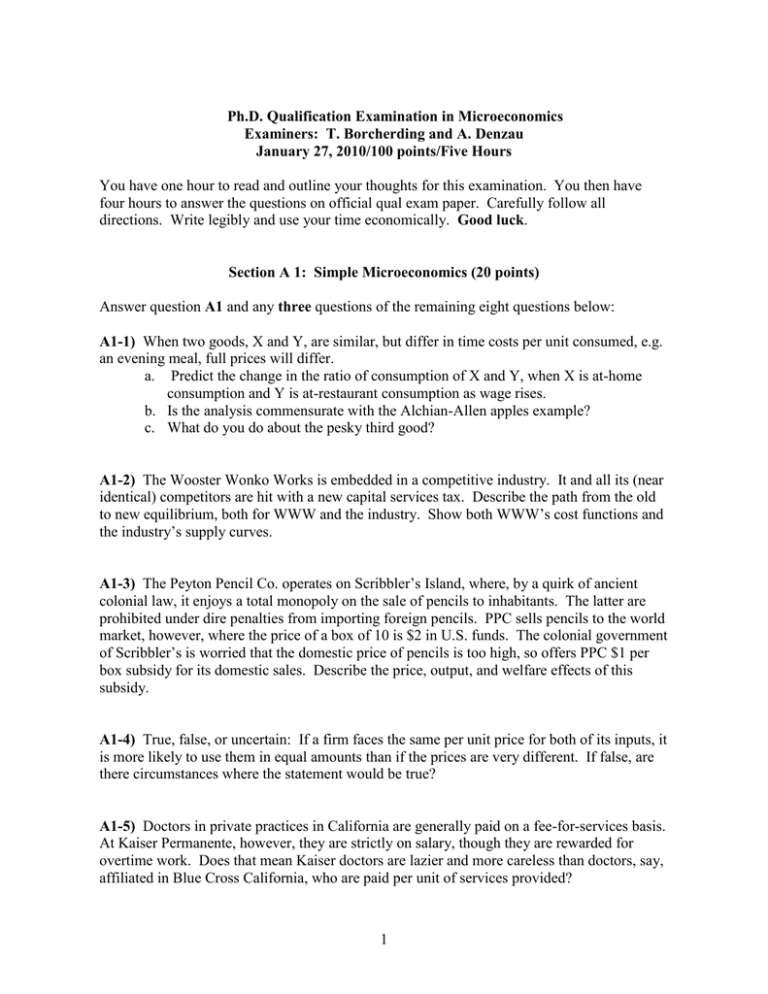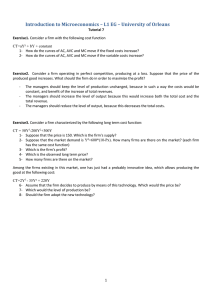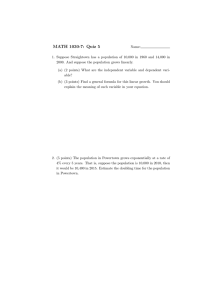Ph.D. Qualification Examination in Microeconomics January 27, 2010/100 points/Five Hours
advertisement

Ph.D. Qualification Examination in Microeconomics Examiners: T. Borcherding and A. Denzau January 27, 2010/100 points/Five Hours You have one hour to read and outline your thoughts for this examination. You then have four hours to answer the questions on official qual exam paper. Carefully follow all directions. Write legibly and use your time economically. Good luck. Section A 1: Simple Microeconomics (20 points) Answer question A1 and any three questions of the remaining eight questions below: A1-1) When two goods, X and Y, are similar, but differ in time costs per unit consumed, e.g. an evening meal, full prices will differ. a. Predict the change in the ratio of consumption of X and Y, when X is at-home consumption and Y is at-restaurant consumption as wage rises. b. Is the analysis commensurate with the Alchian-Allen apples example? c. What do you do about the pesky third good? A1-2) The Wooster Wonko Works is embedded in a competitive industry. It and all its (near identical) competitors are hit with a new capital services tax. Describe the path from the old to new equilibrium, both for WWW and the industry. Show both WWW’s cost functions and the industry’s supply curves. A1-3) The Peyton Pencil Co. operates on Scribbler’s Island, where, by a quirk of ancient colonial law, it enjoys a total monopoly on the sale of pencils to inhabitants. The latter are prohibited under dire penalties from importing foreign pencils. PPC sells pencils to the world market, however, where the price of a box of 10 is $2 in U.S. funds. The colonial government of Scribbler’s is worried that the domestic price of pencils is too high, so offers PPC $1 per box subsidy for its domestic sales. Describe the price, output, and welfare effects of this subsidy. A1-4) True, false, or uncertain: If a firm faces the same per unit price for both of its inputs, it is more likely to use them in equal amounts than if the prices are very different. If false, are there circumstances where the statement would be true? A1-5) Doctors in private practices in California are generally paid on a fee-for-services basis. At Kaiser Permanente, however, they are strictly on salary, though they are rewarded for overtime work. Does that mean Kaiser doctors are lazier and more careless than doctors, say, affiliated in Blue Cross California, who are paid per unit of services provided? 1 A1-6) Lord Jim Dandy is the Proconsul of Newtonia. His subjects consume only three goods, X, Y, and N, where N is leisure. He taxes the first two, but has no way of taxing the latter. Jim is told by his economic advisors that X is a strong complement of N, whereas Y is a strong substitute for it. Jim is a tyrant, but not interested in making his subjects any more unhappy than they already are at the high taxes levied to support his profligate government. Currently the tax rates on X and Y are equal, 35%. His economists make a suggestion to alter the rates. What will they say? A1-7) Capital services are very durable, but can change if market conditions dictate. Currently, in San Bernardino County and many other areas of the U.S., the housing stock is hugely excessive due to the collapse of the mortgage market some recent time ago. There is serious pressure on the Obama Administration to “bail out” the U.S. housing industry in the short-run. Describe the equilibrium path such an intervention implies, paying attention not only to short- and long-run, but to stocks, flows, and expectations. A1-8) A firm in a competitive industry discovers a major technical breakthrough in the production of X that doubles the productivity of its labor. How are wages affected if this technique is patentable and how are wages affected if no patent is possible? A1-9) If one wants a "back of the envelope" calculation for the effect on competitive price in a constant cost industry of a change in wages, you just multiply the percentage change of the latter by its share of industry cost times price. If, however, one wants a more nuanced measure, one needs a localized production function to plug in to get an analytic solution. That second change will always be smaller than the first. Why so? 2 Section A 2: New Institutional Economics and Political Economy (20 points) Answer any three of the nine questions below: A2-1) The size of firm obviously is dependent upon neo-classical issues such as relative factor prices and its production function mapping (which captures the division of labor and specialization economics, as well as the level of technology). Economists from Adam Smith to Ronald Coase and Oliver Williamson, however, suggest that the economics of coordination and control are hugely important, too. True, false, or uncertain: if it were not for the “transactions” issues, all firms would be the same, and there would not be hierarchal firms at all. A2-2) Firms typically reject as employees job candidates who are “over-qualified.” a. Why is this and is it efficient? b. Would this persist if these exclusions were in the midst of a severe dislocation in an economy, such as today’s? A2-3) The empirical contribution of behavioral economics has suggested that people are not nearly as rational as neo-classical assumptions imply. Behavioralists are suggesting public sector interventions to correct these failings. It has been discovered, however, that Frederick Hayek argued fifty years ago that although men and women indulge in behavior that is foolish and often rash, private institutions develop without centralized coordination to constrain these ill considered actions, at least to some extent. Some are calling this the Coasean approach to socio-economics. What are the strengths and limitations in the Hayekian approach to human frailty? A2-4) John Lott argued in a memorial conference a decade ago honoring the late Mancur Olson that the policy behavior of autocracies should not differ greatly than for democracies, except for the distribution of rents. Predict the reaction of the other four members of the panel (one of whom is grading this qual) using your understanding of the public choice of autocracy vs. democracies. A2-5) The late George Stigler argued that the study of public policy by economists should only tred on positive-predictive issues, since normative suggestions were near useless. He thought that all the information relevant to public choice-making was already captured in the market for votes and legislation. What are your thoughts on this “efficient market”-type position? A2-6) U.S. and OECD economists generally have shown that free trade is, by their learned assessments, efficient. This position is accepted by 95% of AEA economists and by a huge fraction of the staffs of appointed public bodies and elected politicians. Even so, tariffs and quotas persist. If it is so likely free trade is Paretean, why then do restrictions persist? 3 A2-7) The factor prices facing firms in the U.S. and Japan are reasonably similar, yet the corporate structures often look very different. How come? A2-8) Professor Joel Waldfogels’ new book, Scroogenomics, suggests 20% of gifts during the recent holidays were inefficiently wasteful. He suggests everybody should give gift cards or cash. Professor Deirdre McCloskey in her Vices of Economists suggests Waldfogel is not too great an analyst. Weigh in on the alleged utility or wastefulness of holiday in-kind gifts, offering, as you do, a testable proposition or two. A2 Extra Credit (worth up to five (5) points of credit lost in this section) Tiger Woods’ Swedish wife and former bikini model Elen Nordegan, in the face of his scandalous behavior with many women, has left him and divorce is rumored. She is likely to realize a huge financial settlement. Various important politicians in the U.S. have behaved almost as badly, but their wives have oft-times “stuck by her man.” Is Tiger’s wife doing it because of the huge amount of money, or is marriage different for political families? You might consider the example of the current U.S. Secretary of State and her husband, whose string of dalliances was probably up to Tiger’s level (though this can’t be proven). (Consider in your answer the difference between consumer theory and that of the firm.) [Hint: You might consider in your answer the difference if you use demand theory and marriage as a consumer good or the theory of the firm where parties have non-separable production functions.] 4 Section B: Questions in Advanced Microeconomics (30 points) Answer either B1 or B2, but not both. B1) Suppose a firm uses a technology that can be represented by the production function: q = AK1/4L1/4, A > 0. Suppose that initially A = 1, w = 1, r = 1. There are 10 firms with this same technology. Suppose that demand is given by the demand function: Q = 45 – 2p. a. At market equilibrium, what are market price, transaction quantity, and the output of each firm? b. Suppose that the number of firms were to double. How would this affect the values you found in (a) – give numbers? c. With the ten original firms, suppose that A now equals 2. How does this affect the quantities you find? d. Starting at the same situation as in (a), if r rises to 25, how do the values change? B2) Suppose a consumer's direct utility function is U = x11/3 x21/3. a. Derive the expenditure function, and the indirect utility function. Let p2 = 4, and income $100. Suppose that p1 rises from $1 to $4. b. What is the initial utility level – you can transform it first, but state so and give the new one? The final utility level after the price change? c. Suppose the consumer demands compensation for the price increase. How much is the compensation if 1. the consumer gets compensated for the price increase at their original consumption levels? 2 the consumer is not to be harmed by the price increase? d. What is the least costly policy to restore the consumer to their original level of satisfaction: A - an income supplement, B - a price subsidy for good 1 of $, or C – an in-kind free-to-the-consumer provision of units of good 1? 5 Section C: Questions on Game Theory (30 points) Answer either question, but not both: C1) Consider the following hidden information problem. Suppose that a principal wishes to hire an agent to complete a one-time project. The agent’s effort level is fully observable. The agent’s disutility of effort is not observed by the principal. Suppose that effort can be measured by a one-dimensional variable e, where e is nonnegative. Gross profits (excluding wage payments) are a deterministic function of effort, (e), with (0)=0, ’(e)>0, and ’’(e)<0 for all e. The agent maximizes expected utility, and has the following utility function defined on certain outcomes: U(w,e,t)=v(w-g(e,t)), where t is a state of nature that is realized after the contract is signed. The agent observes t. The function g(e,t) measures the disutility of effort in monetary units. Assume that g(0,t)=0, ge(e,t)>0 for e>0 and ge(e,t)=0 for e=0, gee(e,t)>0 for all e, gt(e,t)<0 for all e, and get(e,t)<0 for e>0 and get(e,t)=0 for e=0. Further, assume that v’(.)>0 and v’’(.)<0. Assume that t can only take on two values, th and tl, where th>tl and Prob(t=th)= . a. Briefly interpret the above assumptions made on the g(e,t) and v(.) functions. b. Assume that the principal can observe t. In this case the principal can specify a (w,e) pair for each value of t. Show how to solve the principal’s problem, and discuss the features of the optimal contract. c. Assume that the principal cannot observe t. Further, assume that the agent must receive a utility at least as high as his reservation utility in each state. Show how to solve the principal’s problem, and compare the features of the optimal contract to the contract obtained in part b. 6 C2) Consider a game played between a monopolist M and a potential entrant E. E can enter using strategy in1, enter using strategy in2, or stay out of the market. M can observe whether E entered the market, but cannot tell whether E used in1 or in2. After observing entry, M either punishes E or does not. Suppose that the payoffs are as follows: if E stays out, E gets 0 and M gets 5. If E plays in1 and M punishes, E gets and M gets -3. If E plays in1 and M does not punish, E gets 2 and M gets 3. If E plays in2 and M punishes, E gets -2 and M gets -3. If E plays in2 and M does not punish, E gets 4 and M gets -5. a. Draw the game tree. b. Define a weak perfect Bayesian equilibrium. c. Describe how M's optimal choice depends on his beliefs. d. Describe how E's optimal choice depends on M's choice. 7




